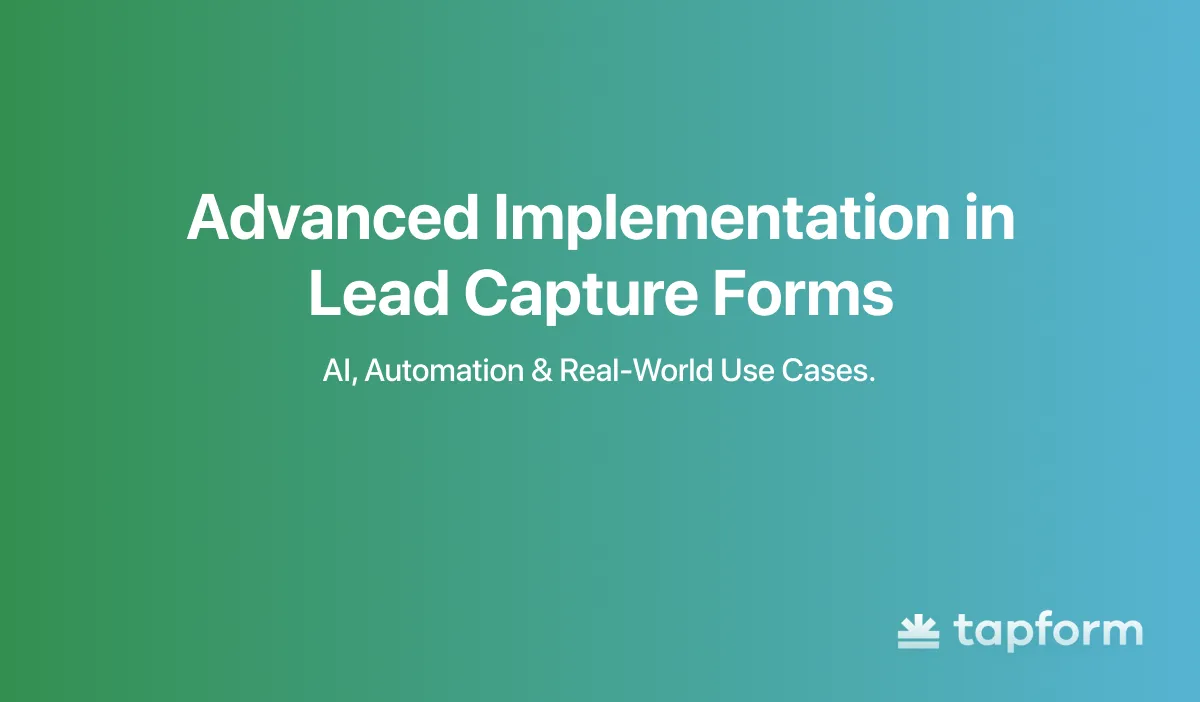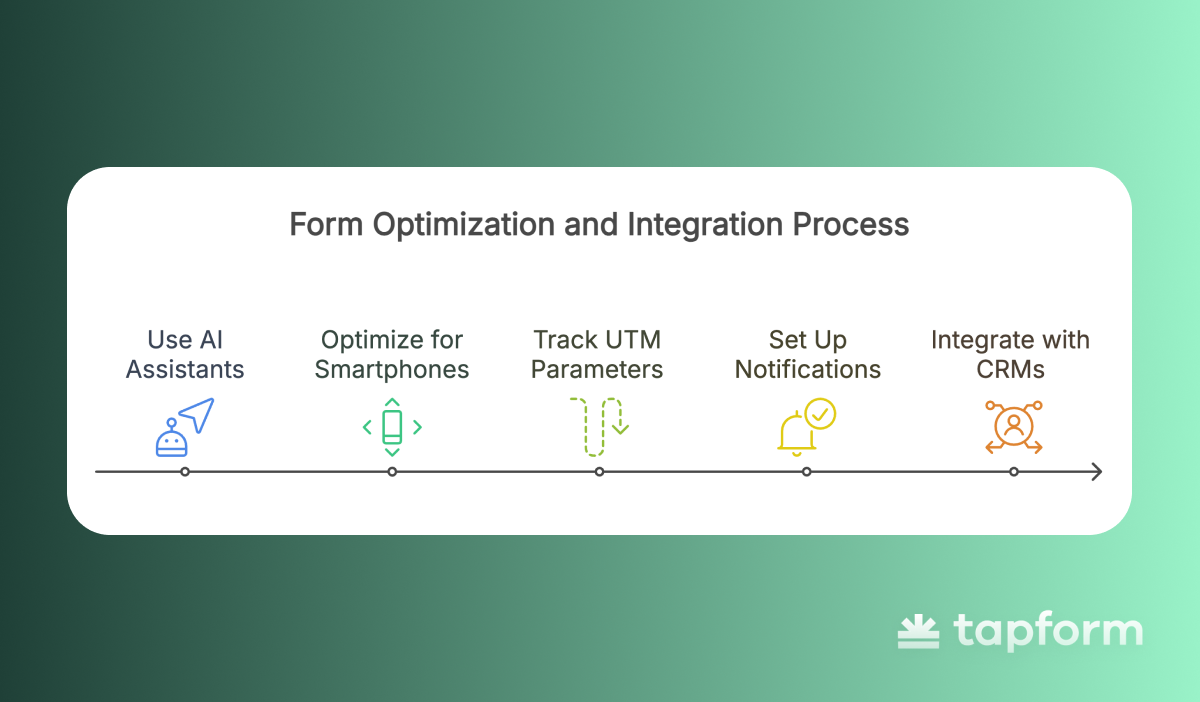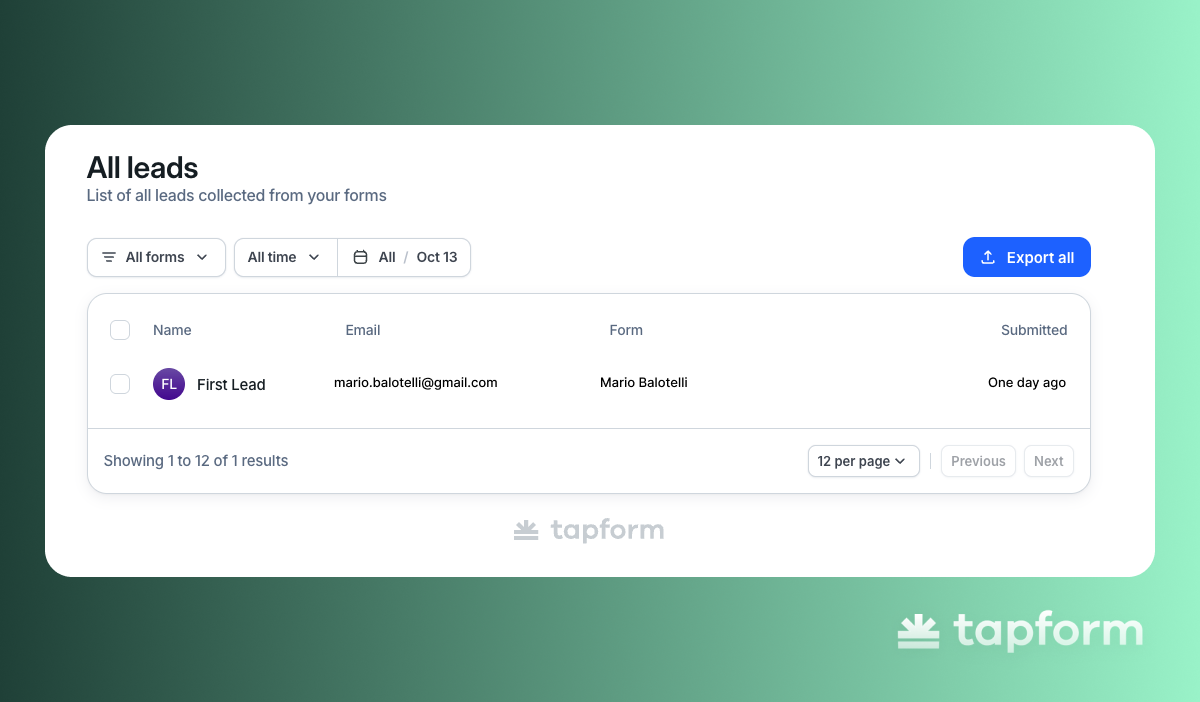Learn 5 Advanced Lead Capture Form Implementations

Lead capture has evolved beyond collecting names and emails. With AI, automation, and smart integrations, modern forms enable businesses to save time, boost conversions, and turn every interaction into tangible results.
A lead capture form collects basic information, such as names and email addresses. However, today’s businesses require more advanced tools. Modern forms now seamlessly integrate with other systems, automating processes to save time and increase conversions.
With modern solutions, forms may do more than simply gather data. AI can guide users by answering questions, providing helpful suggestions, and automating routine steps throughout the process, while mobile optimization ensures that your users have a smooth experience on their smartphones. UTM tracking allows you to identify which campaign generated the most effective leads for you. Instant notification will alert your team, while one-line integration will connect the form directly to your CRM or email tools.
Advanced lead capture goes beyond just online forms.
These innovations are not limited to the web. They work just as well in real-world settings. At trade shows, digital forms and CRM syncing enable faster and more engaging lead capture, often through interactive or gamified experiences. In real estate, tools such as multi-step forms, AI chatbots, and analytics help agents focus on the right prospects at the right time. No matter the setting, the goal stays the same: move beyond collecting data and build a system that turns it into action.

What is an advanced approach to lead capture forms?
Basic lead capture will project basic information, like names and emails. However, an advanced variant can further leverage tools, integrations, and smart features to enhance the form's strength, saving time in execution and focusing on higher conversion rates.
Advanced lead capture forms not only collect information but also directly connect to your marketing tools, providing valuable insights into user interactions and behavior.
- Utilize AI assistants to guide visitors through the form and provide real-time answers to their questions.
- Optimize forms for smartphones to ensure mobile users have a smooth and fast experience.
- Track UTM parameters inside your forms to measure exactly where leads are coming from.
- Set up notifications so you never miss a new submission.
- Integrate your forms with CRMs, email tools, or automation platforms for instant follow-up.
Each of these steps helps you move beyond simple data collection and build a system that actually drives conversions and sales.
Set up AI Assist to use for lead capture.
Integrating an AI assistant with lead capture forms transforms a form from a static set of fields into an intelligent and interactive experience. Instead of a user filling in fields, the AI guides them through the process, answers their questions in real-time, and modifies the journey based on their responses.
One of the most interesting usages for AI is in building the forms themselves. Nowadays, with many tools, you simply tell them a bit about your business and what you do, and they spit out a form tailored just for you.
This removes the guesswork, speeds up setup, and ensures your form is aligned with your goals from the very start.
This approach enhances efficiency by minimizing manual labor. The AI can also automatically qualify leads based on their responses and recommend tailored next steps, ensuring you focus on the most promising prospects and streamline follow-up actions.
Tapform’s AI Form Builder
How to Implement a Lead Capture Form on a Smartphone ?
Most visitors use phones, so optimize your lead capture forms for mobile use. Keep forms concise and only request essential information, as mobile users prefer quick and simple input.
Reduce friction: ensure forms load quickly, use dropdowns or toggles, and limit the number of taps needed for completion.
A good user experience also means using:
- clear layouts
- large fonts
- large, easily-tapped buttons to prevent errors.
Most modern form builders have built-in mobile optimization, so you won’t need to adjust layouts manually. Still, always test your form on different devices for a smooth user experience.
How to Track UTM Parameters in Lead Capture Forms?
If you want to know exactly where your leads are coming from, UTM parameters are the key. You’ve probably noticed long links with extra text at the end, starting with a question mark . That’s called a query string, and it tells tools like Google Analytics important details about traffic sources.
For example, if someone clicks a link to your website from another site, Analytics can usually detect the referral automatically. However, if the link is in an email, there’s often no referrer data, so the visit would appear as “direct.” That’s where UTM parameters come in. By adding short codes like:
utm_source=email or utm_campaign=winter_sale
to your links, you tell Analytics exactly where the visitor came from.
When a user clicks a link with UTM tags and then submits your lead capture form, those parameters can be captured along with their details. This way, you don’t just know who the lead is, but also how they found you.
Advanced form builders make this easy - they automatically read UTM values from the URL and store them in your dashboard or CRM, so you can later analyze which channels drive the highest-quality leads.
How to set up notifications for the lead capture form ?
Once you’ve tested your lead capture form and confirmed that everything works, the next step is to set up notifications. Notifications ensure that you or your team are alerted immediately when a new lead comes in, so no opportunity is missed.

Previously, email alerts were commonly used; however, messages often ended up in spam folders or were overlooked in crowded inboxes, among other issues. Today, sophisticated tools for lead capture forms address the problem by issuing pop-up notifications within their own platforms or through integrations with platforms like Slack and CRM systems.
How to Set Up & Integrate a Lead Capture Form?
The first step in setting up a lead capture form is to define clear goals. Determine what information you need to collect and how it will be utilized, then identify the required fields that support these goals without overwhelming users. Once this is in place, you can proceed with implementation.
In the past, integrating forms often required developer time and custom coding. Today, modern tools like Tapform make the process much easier. With just a single line of code, you can add a fully functional form to your website in under a minute. This no-code approach means you don’t need technical skills or IT resources.
What are Advanced lead capture techniques for trade shows ?
Trade shows remain one of the most effective ways to connect directly with potential customers. Business cards and sign-up sheets are outdated methods, but modern tools enable faster and more accurate lead capture. Digital forms and mobile apps help teams collect and organize leads effectively.
A great example is a multi-step lead capture form. It can sort visitors based on their answers. If someone selects enterprise solutions, they can be tagged as a high-value lead. If they choose personal plans, they can be added to a nurturing list. This way, you get more than a list of names and can see which leads need attention first.
CRM integrations send trade show data straight into your sales system. Gamified quizzes or prize wheels add a fun touch and encourage more people to take part.
What are Advanced Lead Capture Techniques For Real Estate ?
In real estate, just as in trade shows, it’s important to use methods that do more than just collect contacts - they should help you understand and prioritize prospects. Tools like AI-powered chatbots can instantly answer property questions and guide people toward the right next step, while predictive analytics help agents identify which leads are most likely to convert. To spark initial interest, mortgage calculators or neighborhood guides are effective in attracting attention, while targeted advertisements deliver the offers to the right audience.
It's also beneficial to know that multi-step lead capture forms can make a significant difference. They, rather than bombarding a visitor with questions all at once, guide them through the process, asking only what's relevant. An example of this might be buyers being asked about a budget range, and renters seeing questions relating to lease terms.

